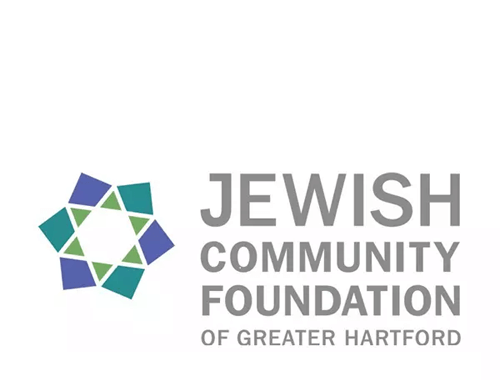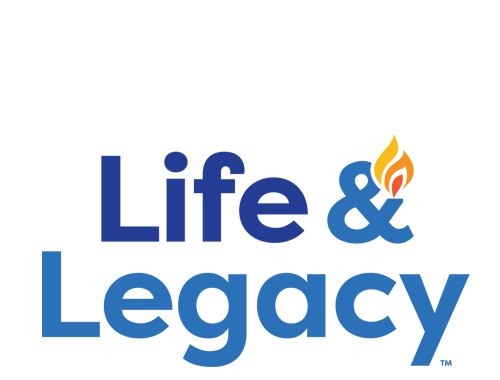Schechter Shavua: June 6, 2025
Kindergarteners are Torah Scholars and Photographers
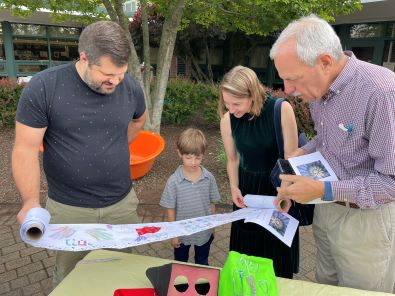 Ilanot students (Kindergarten) recently demonstrated their ability to think like Torah scholars, looking for details, asking questions and looking for deep answers. Throughout the year, they have focused on Genesis and Exodus, learning the name of each parashah and creating a piece of art that accompanies it. At the end of the year, these individual parashah pages were glued together and rolled into a beautiful handmade torah. The students also learned the parts of the torah and dressed their torahs with a belt, a special cover that they designed themselves, and a handmade yad.
Ilanot students (Kindergarten) recently demonstrated their ability to think like Torah scholars, looking for details, asking questions and looking for deep answers. Throughout the year, they have focused on Genesis and Exodus, learning the name of each parashah and creating a piece of art that accompanies it. At the end of the year, these individual parashah pages were glued together and rolled into a beautiful handmade torah. The students also learned the parts of the torah and dressed their torahs with a belt, a special cover that they designed themselves, and a handmade yad.
Students also learned how to use an ipad to take photos, including techniques like close ups, selfies, staged and natural pictures. They circled the school, inside and out, with a keen eye to take pictures centered around topics of their choosing before editing them down to their favorite few photos. Students created beautiful marbled paper and designed the covers. They stitched their books together, using sticks to secure the twine for a more rustic look. Throughout the process, students felt ownership and pride in the final outcome.
Parents and other special adults were privileged to witness the culmination of the Kindergarten learning. At the end of this culmination, they shared in prayer together before receiving their first siddur.
Click HERE to see photos of this special culmination.
Alim Showcases Interdisciplinary Learning
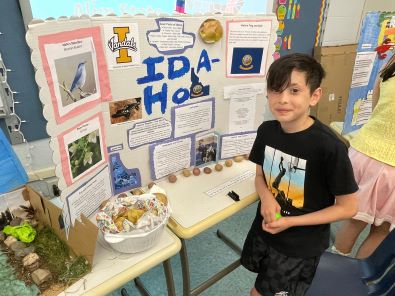 In a fun role-switch, Alim students (grades 3-4) taught their parents last week at the States Fair! This culmination of a months-long interdisciplinary project integrated work from Social Studies, Science, and Makerspace, showcasing students’ learning process, effort and creativity.
In a fun role-switch, Alim students (grades 3-4) taught their parents last week at the States Fair! This culmination of a months-long interdisciplinary project integrated work from Social Studies, Science, and Makerspace, showcasing students’ learning process, effort and creativity.
Beginning in early March, students selected a U.S. state to research. They first gathered information from books, then expanded their knowledge using online sources, all of which was compiled by hand into a research packet. Next, students revised their writing and transferred it into a Google Doc.
For their finished project, each student produced a presentation board (generously provided by the Schechter PA), a handmade 3-D artifact, a printed travel pamphlet, a hand-sewn pennant created in Makerspace, and a clay model of their state bird’s habitat—researched and crafted in Science class. As all the Alim parents circulated the room, students proudly explained their research and skillfully answered questions.
Students Recognized for Efforts to Address Historical Injustices
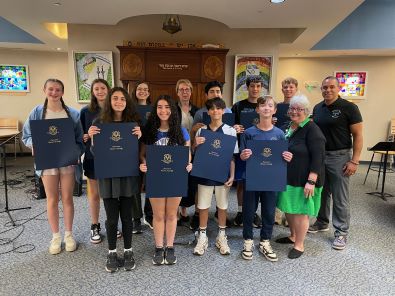 Amirim 8th graders , recognized for their civic engagement, had the distinct honor of meeting CT State Senator Cathy Osten (19th District) and Mashantucket Pequot Tribal Chairman Rodney Butler. Following an impactful conversation, Senator Osten presented an Official Citation to each student, commending them for their meaningful involvement in the legislative process, specifically recognizing their efforts to address historical injustices. As covered in a previous Schechter Shavua, the students had written a letter in support of condemning the 1638 Treaty of Hartford, which called for the destruction of the Pequot people and their language. Senator Osten was so moved by their advocacy that she shared the students' letter with her colleagues to show that young people genuinely care about this important issue.
Amirim 8th graders , recognized for their civic engagement, had the distinct honor of meeting CT State Senator Cathy Osten (19th District) and Mashantucket Pequot Tribal Chairman Rodney Butler. Following an impactful conversation, Senator Osten presented an Official Citation to each student, commending them for their meaningful involvement in the legislative process, specifically recognizing their efforts to address historical injustices. As covered in a previous Schechter Shavua, the students had written a letter in support of condemning the 1638 Treaty of Hartford, which called for the destruction of the Pequot people and their language. Senator Osten was so moved by their advocacy that she shared the students' letter with her colleagues to show that young people genuinely care about this important issue.
Chairman Rodney Butler’s presence added an extraordinary layer of significance to the visit. Often described as akin to meeting a president, Chairman Butler engaged thoughtfully with the students, answering their questions and explaining the concept of domestic sovereignty. His insights provided students with a deeper understanding of tribal governance and history. Senator Osten encouraged the students to remain civically engaged and even consider running for office in the future. The entire experience was both affirming and inspiring for the students, who were deeply honored by the recognition. It was evident that both Senator Osten and Chairman Butler were equally moved by the students' passion and commitment to justice and historical truth.
Many thanks to the Connecticut General Assembly for these citations, specifically to Senator Osten, Senator Derek Slap, Representative Tammy Exum, and Representative Toni Walker.
EC Goes In-Depth into Artists and Styles
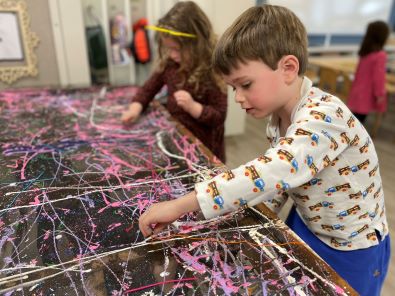 Over the past few months, our Early Childhood classrooms dove into the colorful and creative worlds of famous artists—each class drawing inspiration from a unique style to spark imagination, learning, and self-expression.
Over the past few months, our Early Childhood classrooms dove into the colorful and creative worlds of famous artists—each class drawing inspiration from a unique style to spark imagination, learning, and self-expression.
Nitzanim Alef (EC2) discovered the geometric brilliance of Sol LeWitt! With strips in bright hues, students created collaborative artwork inspired by his patterns and wall drawings, learning how lines and shapes can build something bold, beautiful, and full of intention.
Nitzanim Bet (EC2), observed nature’s details through Georgia O'Keeffe’s oversized flower paintings. Using watercolor and coffee filters, students explored how simple elements can become extraordinary when viewed through an artist’s eyes.
Shorashim Alef (EC3-4) celebrated the vibrant spirit of Frida Kahlo! Students created self-portraits with colorful paints and floral touches, discovering how art can reflect our unique identities.
Shorashim Bet (EC3-4) splattered paint and explored movement, color, and emotion in the style of Jackson Pollock! Using a massive screen as their canvas, students learned that creativity has no rules—just joy, freedom, and expression.
Our young artists are not just making art—they’re learning to see the world in new ways.
See photos HERE of the work behind the EC Culmination!
Parashat Naso—A Pluralism of Meaning
 There’s an old joke about Mr. Schwartz, who goes to synagogue every week. One day, his son says to him, “You know, dad, I’ve always admired your deep faith in God. Every week, you go to shul, and sit next to Mr. Goldberg. I’ve always been a little sad that I don’t have that same belief in God.”
There’s an old joke about Mr. Schwartz, who goes to synagogue every week. One day, his son says to him, “You know, dad, I’ve always admired your deep faith in God. Every week, you go to shul, and sit next to Mr. Goldberg. I’ve always been a little sad that I don’t have that same belief in God.”
“Belief in God?” said Mr. Schwartz, “I don’t believe in God! But Goldberg does. He goes to synagogue to talk to God. I just go to synagogue to talk to Goldberg!”
Rabbis usually tell this joke to acknowledge that we all have different reasons for doing what we do—and that’s fine, because in the end, we are doing something good.
This lesson is beautifully expressed in a comment by Ramban on this week’s parashah . The end of the parashah describes how the prince of each Israelite tribe brought gifts to the dedication of the mishkan/desert sanctuary. The whole description is 89 verses long; here is a sample:
On the fourth day, it was the chieftain of the Reubenites, Elitzur ben Shede’ur. His offering: one silver bowl weighing 130 shekels and one silver basin of 70 shekels by the sanctuary weight, both filled with choice flour with oil mixed in, for a grain offering. One gold ladle of 10 shekels, filled with incense. One bull of the herd, one ram, and one lamb in its first year, for a burnt offering. One goat for a purification offering. And for his sacrifice of well-being: two oxen, five rams, five he-goats, and five yearling rams. That was the offering of Elitzur ben Shede’ur.
Imagine that, repeated twelve times. On a computer, we can type it once, do some copying and pasting, change the names, and be done. But if you were a scribe, and you had to painstakingly write this by hand twelve times, you’d be frustrated. Why didn’t the Torah just say, “They each brought the following…”?
Ramban suggests that each prince gets his own paragraph because each brought the same gifts—but for different reasons. For example, the first was Nachshon ben Aminadav. He thought to himself, “The future kings, David and Solomon and the Messiah, are going to come from my tribe, Judah, and they will rule over land and sea. So, I will bring a silver bowl to symbolize the sea, and a basin shaped like the land. The small basin will weigh 70 shekels to symbolize the seventy nations of the world, over whom the Messiah will rule.” To Nachshon, each gift had royal symbolism.
On the second day, Netanel ben Tzu’ar brought the same exact gifts—but for different reasons. According to tradition, he knew that his tribe would produce many Torah scholars, and Torah is often compared to bread, and the Mishkan’s special bread was served in bowls. When he brought the big silver bowl, and each of his other gifts, he was thinking of Torah. The third prince was from the tribe of Zevulun, which would later settle on the Mediterranean coast and engage in trade. To him, the big basin symbolized the sea. Because each tribe understood the gifts differently, each one was listed separately.
We sometimes think that there are two choices: individualism or conformity. Either we do our own unique thing, or fall into line with everyone else. But Ramban suggests a third way: we can be unified in our actions, but each have our own reasons. And we can do this even if we aren’t tribal leaders; there are no dynasties when it comes to personal meaning. By finding our own “why,” we can transform both ourselves and our communities.
Shabbat shalom,
Rabbi Jonathan Berger
Head of School
Questions for the Shabbat table:
- The tribe of Dan was associated with judges; the tribe of Issachar, with independence of spirit. Try to come up with an interpretation of the bowl, basin, and ladle that fits one of those tribes!
- Can you think of a Jewish practice that you do, but for a personal, non-standard reason? Share it with your family—and ask them to share too.
Solomon Schechter Day School
of Greater Hartford
26 Buena Vista Road
West Hartford, CT 06107
© Solomon Schechter Day School of Greater Hartford | Site design Knowles Kreative

